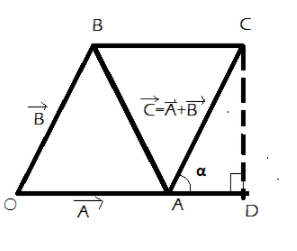
Find the magnitude and direction of the resultant of two vectors \[A\] and \[B\] in terms of their magnitudes and angle \[\theta \] between them.
Answer
505.5k+ views
Hint: In order to solve this question, we are first going to consider the two vectors, and consider the magnitudes for them. Now, we will consider the parallelogram with the two vectors \[A\] and \[B\], and the resultant is given by the diagonal of the parallelogram. Then, the magnitude and direction of the resultant are found.
Formula used:
The Pythagoras theorem is given by,
\[O{C^2} = C{D^2} + D{O^2}\]
Where, \[OC\] is the hypotenuse, \[CD\] and \[DO\] are base and perpendicular.
Complete answer:
It is given that there are two vectors \[A\] and \[B\], such that their magnitudes are
$ \left| A \right| = a \\
\left| B \right| = b \\ $
The angle between them is \[\theta \]
So, if the resultant of these two vectors is taken as \[C\]
Then,
\[A + B = C\]
Now, to find the magnitude and the direction, consider the parallelogram \[OABC\] with \[D\] as the foot of the perpendicular as shown in the figure

Now, in triangle \[OCD\], if we apply the Pythagoras theorem,
\[O{C^2} = C{D^2} + D{O^2}\]
Solving this further, we get
\[OC = \sqrt {O{A^2} + A{D^2} + 2 \cdot OA \cdot AD + C{D^2}} \]
Putting the values,
\[OC = \sqrt {{a^2} + {b^2} + 2 \cdot a \cdot b\cos \alpha } \]
Where,\[AD = AC\cos \alpha = b\cos \alpha \]
Thus, the magnitude of the resultant vector is
\[c = \sqrt {{a^2} + {b^2} + 2ab\cos \alpha } \]
Now, finding the direction, we get
Given that \[C\] makes an angle \[\theta \] with \[A\],
\[\theta = {\tan ^{ - 1}}\left( {\dfrac{{b\sin \alpha }}{{a + b\cos \alpha }}} \right)\]
Hence, the magnitude and direction of the resultant are given by
$ c = \sqrt {{a^2} + {b^2} + 2ab\cos \alpha } \\
\theta = {\tan ^{ - 1}}\left( {\dfrac{{b\sin \alpha }}{{a + b\cos \alpha }}} \right) \\ $
Note: It is important to note that the triangular law of addition has been applied in this question, for the vectors \[A\] and \[B\],
\[A + B = C\]
According to the triangle law of vector addition:
Triangle law of vector addition states that when two vectors are represented as two sides of the triangle with the order of magnitude and direction, then the third side of the triangle represents the magnitude and direction of the resultant vector.
Formula used:
The Pythagoras theorem is given by,
\[O{C^2} = C{D^2} + D{O^2}\]
Where, \[OC\] is the hypotenuse, \[CD\] and \[DO\] are base and perpendicular.
Complete answer:
It is given that there are two vectors \[A\] and \[B\], such that their magnitudes are
$ \left| A \right| = a \\
\left| B \right| = b \\ $
The angle between them is \[\theta \]
So, if the resultant of these two vectors is taken as \[C\]
Then,
\[A + B = C\]
Now, to find the magnitude and the direction, consider the parallelogram \[OABC\] with \[D\] as the foot of the perpendicular as shown in the figure

Now, in triangle \[OCD\], if we apply the Pythagoras theorem,
\[O{C^2} = C{D^2} + D{O^2}\]
Solving this further, we get
\[OC = \sqrt {O{A^2} + A{D^2} + 2 \cdot OA \cdot AD + C{D^2}} \]
Putting the values,
\[OC = \sqrt {{a^2} + {b^2} + 2 \cdot a \cdot b\cos \alpha } \]
Where,\[AD = AC\cos \alpha = b\cos \alpha \]
Thus, the magnitude of the resultant vector is
\[c = \sqrt {{a^2} + {b^2} + 2ab\cos \alpha } \]
Now, finding the direction, we get
Given that \[C\] makes an angle \[\theta \] with \[A\],
\[\theta = {\tan ^{ - 1}}\left( {\dfrac{{b\sin \alpha }}{{a + b\cos \alpha }}} \right)\]
Hence, the magnitude and direction of the resultant are given by
$ c = \sqrt {{a^2} + {b^2} + 2ab\cos \alpha } \\
\theta = {\tan ^{ - 1}}\left( {\dfrac{{b\sin \alpha }}{{a + b\cos \alpha }}} \right) \\ $
Note: It is important to note that the triangular law of addition has been applied in this question, for the vectors \[A\] and \[B\],
\[A + B = C\]
According to the triangle law of vector addition:
Triangle law of vector addition states that when two vectors are represented as two sides of the triangle with the order of magnitude and direction, then the third side of the triangle represents the magnitude and direction of the resultant vector.
Recently Updated Pages
Master Class 11 Economics: Engaging Questions & Answers for Success

Master Class 11 English: Engaging Questions & Answers for Success

Master Class 11 Social Science: Engaging Questions & Answers for Success

Master Class 11 Biology: Engaging Questions & Answers for Success

Class 11 Question and Answer - Your Ultimate Solutions Guide

Master Class 11 Business Studies: Engaging Questions & Answers for Success

Trending doubts
10 examples of friction in our daily life

One Metric ton is equal to kg A 10000 B 1000 C 100 class 11 physics CBSE

Difference Between Prokaryotic Cells and Eukaryotic Cells

1 Quintal is equal to a 110 kg b 10 kg c 100kg d 1000 class 11 physics CBSE

Explain zero factorial class 11 maths CBSE

What is a periderm How does periderm formation take class 11 biology CBSE




